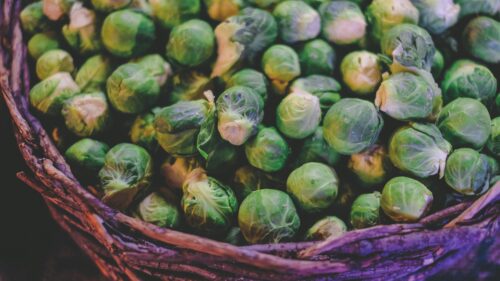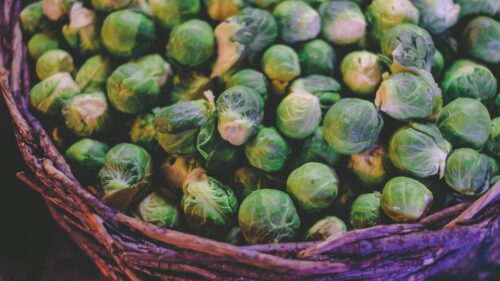As the autumn season rolls in, many people eagerly await the return of seasonal vegetables, and Brussels sprouts are no exception.
These small, cabbage-like vegetables are packed with nutrients and flavor, making them a great addition to any fall and winter meal.

Brussels sprouts, typically harvested between September and February, are at their best during the cooler months when they develop a slightly sweet, nutty flavor.
Whether roasted, sautéed or added to a hearty dish, Brussels sprouts bring a rich and savory taste to the table. Besides their delightful flavor, they are also packed with health benefits that make them a favorite among nutrition-conscious consumers.
Nutritional Benefits
Brussels sprouts are rich in a variety of vitamins and minerals, making them a nutritional powerhouse. One of the most notable benefits is their high concentration of vitamin C. A single cup of cooked Brussels sprouts contains over 120% of the recommended daily intake of vitamin C, which is crucial for immune function, skin health and the absorption of iron. Vitamin C also plays a role in promoting healthy aging by combating oxidative stress in the body.
These little vegetables are also an excellent source of vitamin K, a nutrient essential for blood clotting and bone health. Just one cup of Brussels sprouts can provide more than 250 percent of the recommended daily intake of vitamin K. For people who are mindful of their cardiovascular health, Brussels sprouts offer benefits due to their fiber content, which supports heart health by helping to regulate cholesterol levels and maintain stable blood sugar.
Brussels sprouts are loaded with antioxidants, particularly kaempferol. Antioxidants help protect cells from damage caused by free radicals, which are unstable molecules that can contribute to chronic diseases like cancer and heart disease.
The fiber content also contributes to digestive health, making Brussels sprouts a great choice for maintaining a healthy gut.
Ways To Use
The versatility of Brussels sprouts makes them a star in various dishes. Here are some creative and simple ways to incorporate them into your meals:
Roasted Brussels Sprouts
Roasting is one of the most popular ways to cook Brussels sprouts because it brings out their natural sweetness while adding a crispy texture. Toss halved Brussels sprouts in olive oil, salt and pepper, then roast them in the oven at 400 degrees for about 25-30 minutes. You can add flavor by sprinkling balsamic vinegar, honey or Parmesan cheese before serving.
Sautéed Brussels Sprouts
For a quick and easy side dish, sauté Brussels sprouts in a pan with garlic and olive oil. Thinly slice the Brussels sprouts so they cook evenly and get a nice caramelized edge. You can also throw in bacon or pancetta for a savory twist. Sautéed Brussels sprouts pair well with meat dishes, especially roasted chicken or pork.
Shaved Salad
Raw Brussels sprouts can be surprisingly delicious when shaved thinly and used in salads. Toss the shaved sprouts with lemon juice, olive oil and a sprinkle of Parmesan for a fresh and crunchy salad. You can add nuts like almonds or walnuts and dried cranberries to add some texture and sweetness.
Stir Fry
Brussels sprouts can be added to stir-fries for a quick and easy dinner. Their texture holds up well when sautéed with other vegetables like carrots, bell peppers and onions. Combine with a protein like chicken or tofu, and finish with a soy-based sauce for a delicious and balanced meal.
Brussels sprouts are a highly nutritious, versatile vegetable that comes into season just as the cooler months begin. Their health benefits, ranging from high vitamin C content to powerful antioxidants, make them an excellent addition to any diet. Whether roasted, sautéed or used raw in a salad, Brussels sprouts bring a unique flavor and texture to the table. By incorporating them into your meals this season, you’ll enjoy their taste and reap the many health benefits they offer.
Here’s a scrumptious Brussels spouts casserole for you to try.

Ingredients
8 bacon slices
1 pound Brussels sprouts, blanched for 10 minutes and cut into quarters
1 c shredded Swiss cheese, divided
¾ c heavy whipping cream
Preheat the oven to 400 degrees. Place a skillet over medium-high heat and cook the bacon until it is crispy. Reserve one tablespoon of bacon fat to grease the casserole dish and roughly chop the cooked bacon.
Lightly oil a casserole dish with the reserved bacon fat. Set the dish aside. In a medium bowl, toss the Brussels sprouts with the chopped bacon and ½ c of the Swiss cheese. Transfer the mixture to the casserole dish.
Pour the heavy whipping cream over the Brussels sprouts mixture and top the casserole with the remaining ½ c of Swiss cheese. Bake uncovered until the cheese is melted and lightly browned and the vegetables are heated through, approximately 20 minutes. This casserole can be a meal by itself or served as a side dish. Serves 8.































